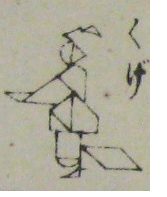In this blog I mentioned Alcuin of Yorks puzzle collection Propositiones alcuini doctoris caroli magni imperatoris ad acuendos juvenes several times. It was possibly published around 800, and contained 53 problems.
A number of these problems are what we now would term “1 equation with 1 unknown”. Among these are a number which expand on a number, performs a number of calculation operations, and give the answer.
Example:
Nr 2: propositio de viro ambulante in via
A certain man walking in the street saw other men coming towards him, and he said to them: “O that there were so many [more] of you as you are [now]; and then half of half of this [were added]; and then half of this number [were added], and again, a half of [this] half. Then, along with me, you would number 100 [men].” Let him say, he who wishes, How many men were first seen by the man?.” How many men were first seen by the man?
Alcuin gives the solution:
Those who were first seen by the man were 36 in number; double this would be 72. A half of half of this is 18, and a half of this number makes 9. Therefore, say this: 72 and 18 makes 90. Adding 9 to this makes 99. Include the speaker and you shall have 100.
To see how this can be solved with elementary algebra, let’s call the number of men x.
– Then that there were so many [more] of you as you are [now]: x+x=2x
– and then half of half of this [were added]: 2x + 0,5x=2,5x
– and then half of this number [were added]: 2,5x + 0,25x=2,75x
– and adding 1 makes 100.
So 2,75x +1 = 100
2,75x=99
11/4x=99
1/4x=9
x=36
Nr 3: propositio de duobus proficiscentibus
Two men were walking in the street when they noticed some storks. They asked each other, “How many are there?” Discussing the matter, they said: “If [the storks] were doubled, then taken three times, and then half of the third [were taken] and with two more added, there would be 100.” How many [storks] were first seen by the men?
This one leads itself for a second way of solving, working backwards:
– with two more added: 100/2=98
– doubled, then taken three times, and then half of the third taken: like in the previous one, the main problem is in figuring out what Alcuin actually meant.
Nr 4: propositio de homine et equis
A certain man saw some horses grazing in a field and said longingly: “O that you were mine, and that you were double in number, and then a half of half of this [were added]. Surely, I might boast about 100 horses.”
How many horses did the man originally see grazing?
nr 36: propositio de salutatione cujusdam senis ad puerum
A certain old man greeted a boy, saying to him: “May you live, boy, may you live for as long as you have [already] lived, and then another equal
Recreational problems Alcuin 5 Albrecht Heeffer amount of time, and then three times as much. And may God grant you one of my years, and you shall live to be 100.” How many years old was the boy at that time?
Nr 40: propositio de homine et ovibus in monte pascentibus
A certain man saw from a mountain some sheep grazing and said, “O that I could have so many, and then just as many more, and then half of half of this [added], and then another half of this half. Then I, as the 100th [member], might head back to my home together with them.” How many sheep did the man see grazing?
Nr 45: propositio de salutatione pueri ad patrem
A certain boy addressed his father, saying, “Greetings, father!” The father responded, “May you fare well, my son, and may you live three times twice your years. Then, adding one of my own years, you will live to be 100.” How many years was the boy at the time?Nr 46: Propositio Recreational problems Alcuin 6 Albrecht Heeffer A dove sitting in a tree saw some other doves flying and said to them, “O that you were doubled, and then tripled. Then, along with me, you would number 100.” How many doves were initially flying?
nr 48: propositio de homine qui obviavit scholaribus
A certain man met some students and asked them, “How many of you are there in school?” One of [the students] responded to him: “I do not want
to tell you [except as follows]: double the number of us, then triple that number; then, divide that number into four parts. If you add me to one of the fourths, there will be 100.” How many [students] first met the man?
I do not intend to publish the solutions of these problems.
There will be more on this topic in my upcoming e-book on number puzzles.




